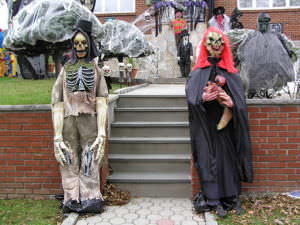Halloween (or All Hallows’ Eve) is celebrated on October 31 in several countries. It has its roots in pagan celebrations for the end of the harvest season, various festivals of the dead, and the Celtic Samhain festival. Day of the Dead (or Dia de los Muertos) is a Mexican holiday, also celebrated in parts of Latin America and the U.S., to remember and pray for family and friends who have died. It is on November 1.
Comparison chart
| Day of the Dead | Halloween | |
|---|---|---|
 |  | |
| Date | October 31 to November 2 | October 31 |
| Country of origin | Mexico | Ireland |
| Purpose | Remember and celebrate friends and family who are dead | An appreciation of the afterlife and the survival after death. Literal meaning is the night before All Hallows' Day (aka All Saints' Day) |
| Celebration | Visit cemetery, leave food offerings shaped like skulls at the altar along with candles, incense and a picture of the dead person | Carve Jack o' Lanterns out of pumpkins, decorate the house with a ghoulish theme, parties, go trick or treating door to door wearing costumes |
| Symbols | Skulls | Pumpkins, ghosts |
| Typical festivity food | Pan de muertos (bread of the dead - skull-shaped bread), candied pumpkins, any favorite food of the celebrated late friend/family member | Pumpkin pie, cookies shaped like pumpkins, ghosts or skulls, candy, cakes made like a graveyard |
| Religion | Christianity | Paganism, Christianity (All Hallows Eve); now modernized and embraced universally as a fun festival |
Origins
Day of the Dead can be traced back to indigenous cultures in Mexico dating back 2,500 to 3,000 years, who had rituals celebrating the deaths of ancestors. The festival originally occurred in the ninth month of the Aztec calendar and lasted for the entire month.
Halloween is believed to have pagan roots, and is linked to the Celtic festival Samhain, when the “door” to the Otherworld was believed to be opened so that the souls of the dead could enter this world. It was also influenced by Christian All Saints’ Day, which honors saints and the recently departed.
This National Geographic Channel video takes a look at the history of Halloween and how it came to be known as an appreciation of the afterlife.
Celebration
The Day of the Dead celebrates and remembers friends and family members who have died. In most parts of Mexico, the Day of the Dead is used to honor children and infant family members that died. Adults are honored on November 2nd. The atmosphere is rather that of a picnic or celebration than mourning. Mexicans embrace death and celebrate the deceased for the time they lived.
This video takes a look at the festival of the Day of the Dead, which is believed to be a celebration of life itself.
Day of the Dead is a national holiday in Mexico, and all banks are closed. It takes place on November 1st. People visit cemeteries and build private altars with the favorite food and drinks of the deceased, as well as photos and other memorabilia, to encourage the souls to visit. Graves are often decorated with orange Mexican marigolds. Toys are brought for dead children, and bottles of tequila, mescal or pulque are brought for adults. Some people wear shells on their clothing, so that the noise when dancing will wake the dead. Rituals vary from town to town.
In contemporary times, Halloween is celebrated by both children and adults. Children dress up in costumes and go trick-or-treating from house to house for candy. They ask the traditional question “trick or treat,” implying that they will cause mischief if no treat is given. Costumes are traditionally supernatural or frightening, but over time, they have changes to be costumes on any theme. Popular games include apple bobbing and visiting haunted houses. Adults also enjoy Halloween with costume parties, often with varying themes that aren't necessarily related to the horror genre.
Symbols
The Day of the Dead is commonly represented by a skull. People celebrating wear skull masks, called calacas. Sugar skulls are given as gifts.
Symbols of Halloween include pumpkins and various tropes of horror literature, including vampires, ghosts and mummies.
By the Numbers
Halloween Statistics
CNN reported that 175 million Americans planned to celebrate Halloween in 2018, spending about $9 billion on the festivities.
There are about 41 million trick-or-treaters in America—children between the ages of 5 and 14. 3.8 million of them are expected to dress as a princess, 2.2 million as Batman and 1.9 million as a Star Wars character. Among adults, a little over 10% will dress as a witch.
Every year about 70,000 acres of pumpkins are harvested and about $7 million is spent on pumpkin spice products during Halloween.







 Thanksgiving in America
Thanksgiving in America  Santa Claus
Santa Claus  Real
Real  Valentine's Day
Valentine's Day  Memorial Day
Memorial Day
Comments: Day of the Dead vs Halloween